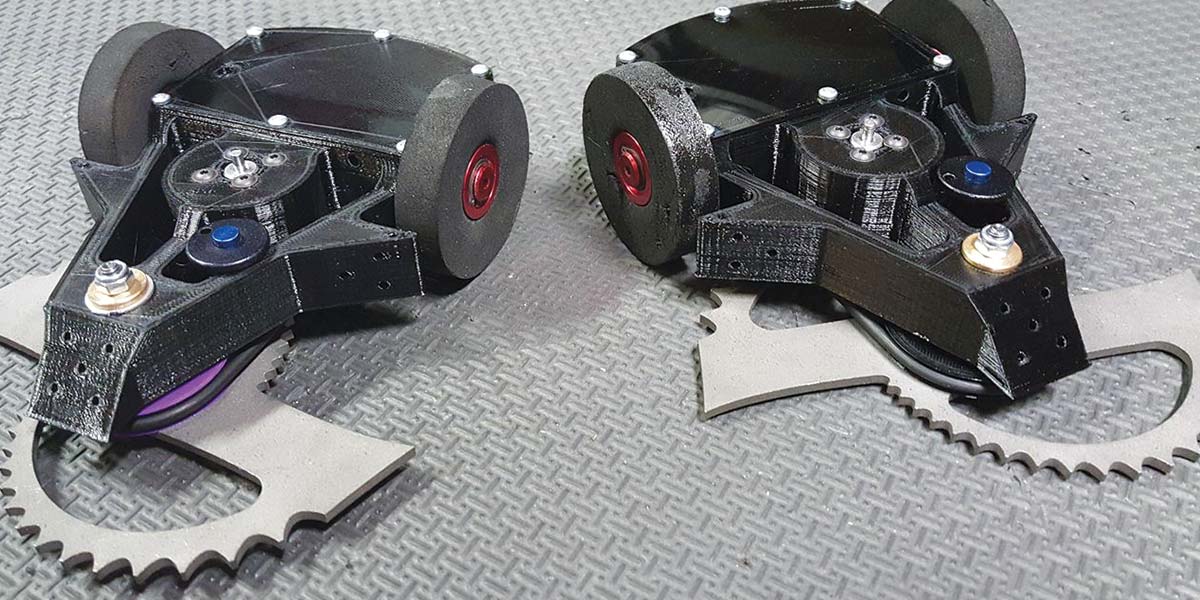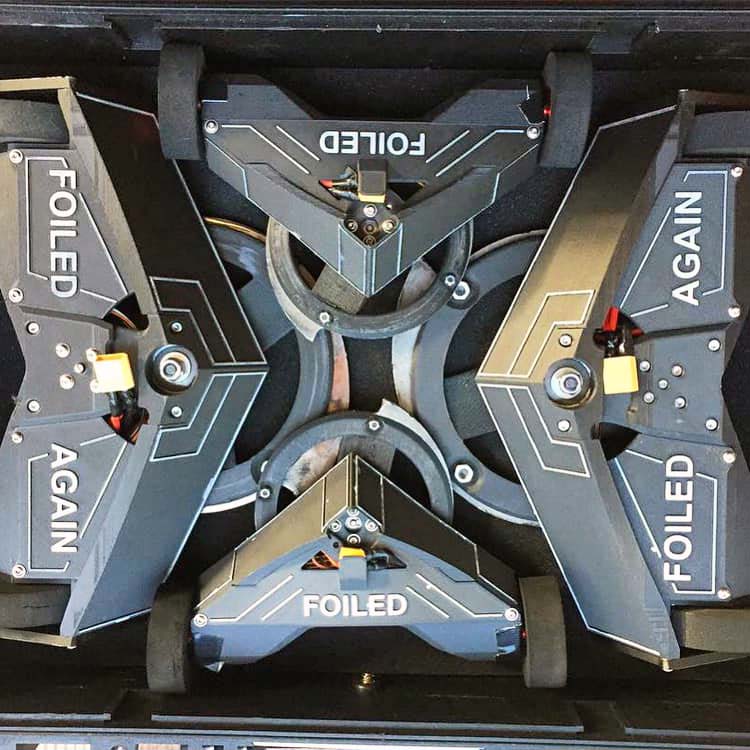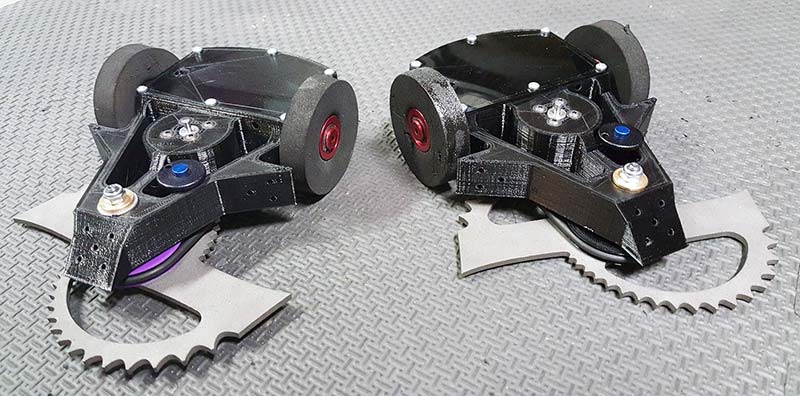
The Bot of Theseus Or “The Sparadox”
By Steven Pasek View In Digital Edition
In combat robotics, damage to your robot is expected; for a bot to leave the match unscathed is highly unusual. Aesthetic damage to the bot such as scuff marks on armor or a slightly bent frame is little cause for concern. It’s a much different story when the delicate internals of a robot are damaged.
Back in the day when BattleBots™ were made out of sticks, stones, and sheet metal, almost anything on the bot could be repaired with duct tape and wires. Presently — with the adoption of modern electronics, such as brushless motors, and advanced manufacturing techniques like 3D printing and CNC machining — repairing a bot is much more involved. It’s no longer feasible to repair a brushless motor or its ESC (electronic speed controller).
Replacement parts are most builder’s only option. With the growing popularity of CNC machined chassis and 3D printed unibodies, repairing a robot’s frame while at competition is almost impossible.
The most recent development has been builders bringing multiple copies of their bots to a competition and swapping them out when one gets too damaged. Examples of this are Bronco in BattleBots Season 2 (2016), and a Facebook post by Valkyrie (October 2018) showing two of each Antweight and Beetleweight bot they were bringing to the Franklin Institute fights.
There was a large response from the community at this post, with many builders viewing this as being against the philosophy of the sport. They argued that while at a tournament, builders should try to repair their bots as much as possible and not substitute identical bots between fights. This article attempts to look at both sides of this argument and discuss the merits of both philosophies.
Schools of Thought
The “Repair” School
The first combat robot philosophy we’ll be looking at is what I’ll call the “repair” philosophy. This school of thought views combat robot tournaments as a competition focused on endurance and durability. The bots are designed to be simple, tough, and easy to repair. Students of this school view tournaments as a test of the builder’s skill in repairing their bot under pressure and their versatility in coming up with ad hoc fixes.
One way to determine a ruling on spares is to look at other similar sports. Followers of the repair school compare combat robotics to fighting sports, like boxing or MMA. There are two opponents in a ring and they try to knock the other out through direct damage. If combat robotics is like boxing, then swapping out a damaged bot for an identical one between fights is the same as a boxer’s twin going in for him/her in the next round when the first twin gets knocked out. This is clearly not the case in boxing.
A fight in boxing is meant to test the endurance of the fighter and how many hits they can take versus how quickly and devastatingly they can dish them out. Boxers don’t usually get ripped in half during a fight though, and have several weeks or months between fights to heal and recuperate; unlike BattleBots, where you can have as little as 30 minutes between fights for repairs.
The “Replace” School
The opposing philosophy is the “replace” way of doing things. Builders in this school of thought think of tournaments as a testing ground for their designs. They aim to test their design in peak condition against different designs also in peak condition to determine which models are superior. For these builders, all the work is done prior to the competition in trying to optimize a design to be successful against the widest range of opponents. Once satisfied with a design, they make multiple copies of it and bring those to competitions and use the time in between fights to relax and think of improvements to their design.
These builders view combat robotics more as an engineering challenge like auto racing. Teams design and build a vehicle to race and have multiple copies and spares in case anything goes wrong. The focus is about the design and building skills of the team and trying original ideas; not in the ability of the team to repair the car during the race. However, race cars aren’t supposed to crash, so they aren’t designed with repairs as such a high priority. If you crash in a race, you’re out; whereas if you get hit in combat robotics, that just means the match has begun.

Double Foils.
Potential Rule Ideas
Almost all builders agree that banning spare parts in their entirety is foolish. Most of the objection comes from the number of spares brought and the degree to which they are pre-assembled. Practitioners of the replace school obviously don’t want any rules limiting the number and arrangement of spares they can bring to matches, so this will focus on what ideas those of the repair school have considered in order to level the playing field. The objective is to allow spares such that no team has an unfair advantage by being too well-equipped. Some methods considered are to limit spares by weight, cost, number, or type.
Limiting spares by weight is relatively straightforward. Each robot would be allotted a certain percentage of its weight class for spare parts of any kind. For example, with a 50% allotment for spares, a 30 lb vertical spinner could bring up to 15 lbs of spare parts. These 15 lbs could be divided amongst a 5 lb disk, two 3 lb motors, and a spare armor piece weighing 4 lbs.
Limiting spares by cost is potentially the most difficult method to enforce. How I imagine it will be set up is that the Event Organizers (EOs) will announce a total cost per bot when the registration for the fight opens. Upon arrival to the event, builders will have to provide receipts proving they did not go over the agreed upon amount. If they went over, spare parts will be confiscated one-by-one until the price limit is reached.
The last methods will probably be combined. Builders would be allowed a certain number of each type of spare components; e.g., four spare drive motors, one spare weapon motor, two spare motor controllers, one spare receiver, etc. This would be relatively easy to enforce provided that EOs are permitted to examine all the toolboxes and containers the teams bring in.
Practical Limitations to the Rules
Any addition to the rules is adding more work to the already full plate of the EOs. If they have to weigh or count up spare parts, it would take many times longer to go through safety inspection and the number of fights held would drop. The other method — setting a budget for each team for an event, and allowing them to either spend all that budget on one bots worth of parts or make a cheaper bot and bring lots of spares — has plenty of issues as well.
How do you ensure the teams followed the budget set forth? What is included in the budget? Are machining and manufacturing costs included? Having your own mill or lathe or having access to a machine shop for cheap offsets a large portion of the cost of the bot. This would give an advantage to more established teams with more resources and hurt teams that are just starting out.
What sort of advantages for teams can be quantified in dollars and regulated to level the playing field? What about education? A five-person team of engineers with four year degrees has literally a million dollars of knowledge. At this point, there is no way to balance fights based on cost.
Speaking of the rushed nature of most combat robotics tournaments, there’s a clear benefit to teams having an extra fully functional bot. If their primary bot is heavily damaged — but repairable — instead of trying for hours to fix it before their next fight, they can just use their secondary bot immediately. This allows fights to proceed much quicker. Spare bots mean faster turnarounds. Faster turnarounds mean more fights. More fights mean more fun.
What Makes a Bot “Itself”
If you replace a broken component in a bot, is it still the same bot? If you replace all the motors in your bot, to the outside observer it’s still the same robot. If you swap out a disk weapon for a bar, most people would agree that it’s the same bot, just with a different weapon. But what if you start swapping out frame components or changing the weapon in a significant way? Is it still the same bot then?
This is a question both sides of the argument have for the other. Those on the replace side think that repairing a bot and changing it significantly between fights is, in fact, using a different bot. Those on the repair side think that replacing damaged components on your bot with undamaged ones makes your bot not the original.
This is an issue in every weight class. However, it’s most visible on the televised shows like BattleBots and Robot Wars. In BattleBots Season 1 on ABC, Biteforce was primarily a lifter/grappler bot, but in the final match against Tombstone, they added a large steel wedge to their rear end and used it to deflect Tombstone’s blade while keeping their lifting arms unused.
Was this still the same Biteforce that fought previously? In Season 2, Biteforce returned with an entirely new design. Instead of a lifter/grappler, it was now a vertical spinner. The announcers of the show treated this Biteforce as the same one that won the previous season, but clearly this was not the same bot, though the paint scheme and name were the same.
Tombstone, on the other hand, has remained mostly unchanged externally forever. Other examples of teams adding things onto their bot before fighting a specific opponent are:
- Ghost Raptor adding the De-Icer fork to keep themselves out of reach of Icewave’s spinning bar.
- Bronco adding a flat extension to the end of their flipper arm to reach under Tombstone’s weapon bar and flip him.
- Carbide adding a metal chain guard after their first fight against Nuts to prevent Nuts’ flails from breaking their chain again.
- Tombstone itself also has different bar geometries to use against different types of opponents.
Season 2 of BattleBots also showcased a previously unseen style of robot: the Swiss Army bot. A conventional BattleBot is designed around one main weapon type, e.g., Tombstone is a horizontal bar spinner; Nightmare is a vertical disk spinner; etc.
A Swiss Army bot, on the other hand, is designed to have interchangeable weapon types.
Bombshell in Season 2 of BattleBots is a prime example of a Swiss Army bot. They had four different weapon configurations: lifter; axe; horizontal bar spinner; and vertical disk spinner.
They ended up using three of those weapon types over the course of the show to great effect, coming in second place. In using different primary weapons, is Bombshell a different robot each time?
I would argue that it is not, since it was designed to use those different weapons and therefore had to make some sacrifices to be more flexible. What if you had a robot like Bombshell but just added a drive chassis to all the weapon modules, effectively making four separate bots. I would argue that these are separate robots and could not compete under one name. The success of one would not mean a success for all.
The Pros Weigh In
This is not the first time this topic has been discussed by the community, and several well-known builders have shared their opinions.
On determining if a bot has been repaired or changed beyond recognition:
I liked the suggestion put forward by Hal Rucker, an experienced builder who competed on BattleBots Season 2 with Ringmaster and Season 3 with DUCK!. His solution was to have a panel of five seven-year-old kids look at a picture of the bot taken when it was registered and compare it to the bot about to enter the match.
If the kids agree by majority vote that the robot in front of them is the same one that’s in the photo, the bot gets to go into battle. The only problem with this idea is if there is a shortage of seven-year-olds at the competition. This rule might mean that Bombshell in Season 2 could not compete in its different weapon configurations.
On whether or not rules are needed for this issue:
Paul Ventimiglia, builder of Biteforce, has this to say: “... what others do doesn’t affect you. Shut up and build and compete however you want. Other people building stuff doesn’t make you lose or make you upset. You make yourself upset and make yourself lose.”
I like his message, which I take to mean as other team’s preparedness is not a reason for them to be restricted to cover your unpreparedness.
There will never be a consensus on what is fair, and trying to restrict the amount or configuration of spare parts teams bring will not work to make things better, and will stifle creativity in the sport.
Someone of the “repair” mindset:
Rory Mangles, builder of Nuts for Robot Wars, has truly seen what can be accomplished on a shoestring budget. In previous seasons of Robot Wars, Nuts was seen as a joke bot, and fared poorly in matches. This all changed in its third appearance on the show, when it showed off its new Melty Brain control system and proceeded to defeat the previous champion, Carbide, in one of the greatest upsets in Robot Wars’ history. This is his view on this debate: “Getting a ruined bot running again in a tight time frame and with limited resources is by far my favorite part of the sport ... But then, I’m weird like that.”

Extra bot made from spare parts.
My Thoughts
I was a participant in Season 2 of BattleBots on a team with some of my classmates from college. It was our first time building any sort of combat robot and we jumped right into the deep end.
We never ended up fighting the bot we brought since we spent the entire time trying to get our bot to work in the first place.
Even so, it was still one of the most fun experiences I have had and it made me very interested in combat robotics in general. I totally understand the viewpoint of those builders who prefer repairing their bot at competition. The race against the clock to get your bot up and running is an amazing thrill.
A few years later, I made a 30 lb Melty Brain bot to compete at Motorama. Again, the bot wasn’t complete when we arrived at the competition, but we were able to get it functional enough to pass safety within a few hours of arrival.
Unfortunately, the design of the bot was very low on space and the frame was machined from a single billet of aluminum, so our ability to repair it at the event was severely limited. We had to forfeit our fights for the weekend. If we could have gotten it running before the competition, we would have needed to bring the equivalent of an entire extra bots’ worth of spares in case of complete destruction. So, I can also support the replace school of thought.
What is the end goal of a tournament? Is it to see which bot is the toughest and most deadly? Or, is it to test your design and building skills against dozens of different designs? Should there be an additional two classes: Fun and Competitive? The Fun class would allow multiple copies of the same bot while the Competitive class would only allow repairs and no spare parts.
BattleBots and Robot Wars are shows; they are broadcast to a large audience and therefore need to be entertaining. Is it more entertaining to see two bots at the top of their game go head-to-head or to see two barely-held-together bots limp around each other for three minutes?
If I had an infinite budget to go on BattleBots, I would definitely bring as many identical copies of the same bot to the event as I could. You start designing your robot with no specific enemies to fight, so you try to make your design work against all weapon types. Then, you take it to a competition and see how it fares against each bot type.
For other builders, the goal of the competition is in maintaining a successful bot and testing the builder’s resourcefulness and technical skill under pressure. Should those that enjoy repairing their bots be the only ones whose voices matter? I think it doesn’t matter as long as you’re having fun.
Conclusion
Is this discussion even necessary? The ultimate goal of combat robotics should be to have fun and learn new things.
Whether having fun to you is making a bot that’s indestructible or making a bot that tries new design methodologies and testing them under different scenarios, the rules shouldn’t stifle creativity or favor one design over another. SV
Article Comments